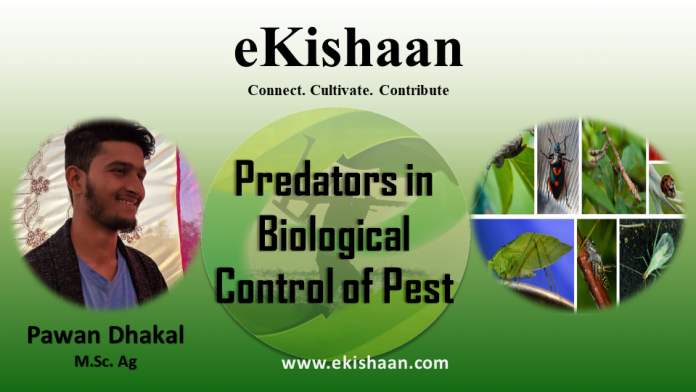Predators in Biological Control of Pest
Natural enemies are fundamental for the implementation of Integrated Pest Management (IPM) (Rosen D, 1985). According to Rice Mahar (2001), insect that eat other insects are either predatory or parasitic, predatory insects or predators are usually much larger than their prey, they eat and kill many preys as they grow and reproduce. Predators will feed on almost anything they can catch but some specialize in consuming certain prey types and act as the alternatives for chemical control of pests. Predators include ladybird beetles, tiger beetle, assassin bug, ground beetles, spiders, lacewings, syrphid (hover) flies, aphid midges, yellow jacket wasps etc. These are considered important agents in biological control to regulate the population of pests in many economically important crops for controlling pest as an alternatives of chemical pest control.
Pesticides should be used only to prevent an economic loss and rarely should be used in a prophylactic manner (Shelton, 2019). All insect pests have natural enemies. The use of these organisms to manage pests is known as biological control. Conservation of natural enemies is probably the most important biological control practice readily available.
Due to the intensive and indiscriminate use of many pesticides, people suffer from many acute poisonings as well as chronic diseases. Besides contaminating food and food products, pesticides have been accumulating in the soil, air and water to a critical stage. This calls for a safe and cheap control method. This can only be achieved by the practice of Integrated Pest Management.
Some Beneficial Predators
According to Washington State University Extension, there are about 25 families of insects that contain predatory species, and virtually all of the more than 100 families of spiders are predatory. Other arachnids like harvestmen (daddy-long-legs) and mites also contain many families which are predatory
| S. N | Predator | Description |
| 1 | Lady Bird Beetle | Mostly lady bird beetle attack on aphids, whiteflies, scales, mites, mealybugs and other soft-bodied insects |
| 2 | Lacewings | It predates mostly on aphids, spider mites, whiteflies thrips, leafhoppers, scales, mealybugs, psyllids, small caterpillars and insect eggs. Green lacewing larvae feed on insect pests. Both larvae and adult brown lacewings feed on pests. Green lacewings are commercially available. |
| 3 | Hover fly | It predates on aphids, scales, thrips and other small soft-bodied insects. |
| 4 | Praying mantids | It preys on many insects including aphids, flies, beetles, moths, crickets, and grasshopper. |
| 5 | Tiger beetle | Tiger beetle feed on rice ear head bug (rice gundi bug) |
| 6 | Assassin Bug | It sucks the fluid from its preys like caterpillar and other many insects. |
| 7 | Spiders | They consume aphids, flea beetle, red pumpkin beetle, leaf hoppers and many more. |
| 8 | Robber Flies | It is the predator flies, wasps, grasshoppers, leafhoppers, beetles, and butterflies. |
| 9 | Predatory mites | It preys on spider mites, thrips, fungus and larvae |
| 10 | Ground Beetles | Prey on cutworms, ants, maggots, earthworms, slugs, and other beetles. |
Benefits of Predators as Natural Enemies
- They are cheap, and ecofriendly.
- They often attack different life stages of the pest, and even different pest species.
- Many predators are also able to supplement their diet by feeding on alternative food sources; they take care of themselves.
- They are often voracious feeders and more robust than parasites.
Limitations of Predators as Natural Enemies
- They usually require higher populations of their prey to work effectively and once they have ‘cleaned them up’ may disappear from the scene.
- It is often difficult to show the impact of predators due to the difficulty in isolating their action among a complex of natural control factors in field situations.
- Need to set up an appropriate home for the predator – nesting habitat etc. not too common in corn fields.
- If the predator is too good, it consumes up all the pest and then migrates out- must be alternate prey.
- Need to have handy a good taxonomist who knows how to id the pest and appropriate predator.
- Introduction of foreign predators has led to problems as they move out into natural systems and outcompete similar native species. They themselves have been known to become pests eventually.
Predators as natural enemies have significant importance as a biological control agent and alternatives options of chemical pesticides. Their commercial rearing, distribution and use in farmer’s field should be increased for eco- friendly and cost effective pest control.
